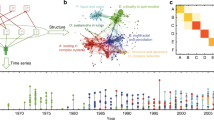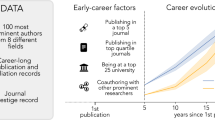Abstract
To understand quantitatively how scientists choose and shift their research focus over time is of high importance, because it affects the ways in which scientists are trained, science is funded, knowledge is organized and discovered, and excellence is recognized and rewarded1–9. Despite extensive investigation into various factors that influence a scientist’s choice of research topics8–21, quantitative assessments of mechanisms that give rise to macroscopic patterns characterizing research-interest evolution of individual scientists remain limited. Here we perform a large-scale analysis of publication records, and we show that changes in research interests follow a reproducible pattern characterized by an exponential distribution. We identify three fundamental features responsible for the observed exponential distribution, which arise from a subtle interplay between exploitation and exploration in research-interest evolution5,22. We developed a random-walk-based model, allowing us to accurately reproduce the empirical observations. This work uncovers and quantitatively analyses macroscopic patterns that govern changes in research interests, thereby showing that there is a high degree of regularity underlying scientific research and individual careers.
This is a preview of subscription content, access via your institution
Access options
Access Nature and 54 other Nature Portfolio journals
Get Nature+, our best-value online-access subscription
$29.99 / 30 days
cancel any time
Subscribe to this journal
Receive 12 digital issues and online access to articles
$119.00 per year
only $9.92 per issue
Buy this article
- Purchase on Springer Link
- Instant access to full article PDF
Prices may be subject to local taxes which are calculated during checkout




Similar content being viewed by others
References
Kuhn, T. S. The Structure of Scientific Revolutions (Univ. Chicago Press, 2012).
de Solla Price, D. J. Little Science, Big Science... and Beyond (Columbia Univ. Press, 1986).
Merton, R. K. The Sociology of Science: Theoretical and Empirical Investigations (Univ. Chicago Press, 1973).
Rzhetsky, A., Foster, J. G., Foster, I. T. & Evans, J. A. Choosing experiments to accelerate collective discovery. Proc. Natl. Acad. Sci. USA 112, 14569–14574 (2015).
Kuhn, T. S. The Essential Tension: Selected Studies in Scientific Tradition and Change (Univ. Chicago Press, 1979).
Sinatra, R., Wang, D., Deville, P., Song, C. & Barabási, A.-L. Quantifying the evolution of individual scientific impact. Science 354, aaf5239 (2016).
Wang, D., Song, C. & Barabási, A.-L. Quantifying long-term scientific impact. Science 342, 127–132 (2013).
Foster, J. G., Rzhetsky, A. & Evans, J. A. Tradition and innovation in scientists’ research strategies. Am. Sociol. Rev. 80, 875–908 (2015).
Clauset, A., Arbesman, S. & Larremore, D. B. Systematic inequality and hierarchy in faculty hiring networks. Sci. Adv. 1, e1400005 (2015).
Jones, B. F. & Weinberg, B. A. Age dynamics in scientific creativity. Proc. Natl. Acad. Sci. USA 108, 18910–18914 (2011).
Packalen, K. Multiple successful models: how demographic features of founding teams differ between regions and over time. Entrep. Reg. Dev. 27, 357–385 (2015).
Duch, J. et al. The possible role of resource requirements and academic career-choice risk on gender differences in publication rate and impact. PLoS ONE 7, e51332 (2012).
West, J. D., Jacquet, J., King, M. M., Correll, S. J. & Bergstrom, C. T. The role of gender in scholarly authorship. PLoS ONE 8, e66212 (2013).
Malmgren, R. D., Ottino, J. M. & Amaral, L. A. N. The role of mentorship in protégé performance. Nature 465, 622–626 (2010).
Guimera, R., Uzzi, B., Spiro, J. & Amaral, L. A. N. Team assembly mechanisms determine collaboration network structure and team performance. Science 308, 697–702 (2005).
Jones, B. F., Wuchty, S. & Uzzi, B. Multi-university research teams: shifting impact, geography, and stratification in science. Science 322, 1259–1262 (2008).
Hoonlor, A., Szymanski, B. K. & Zaki, M. J. Trends in computer science research. Commun. ACM 56, 74–83 (2013).
McNally, A., Prier, C. K. & MacMillan, D. W. Discovery of an α-amino c–h arylation reaction using the strategy of accelerated serendipity. Science 334, 1114–1117 (2011).
Ericsson, K. A. in The Cambridge Handbook of Expertise and Expert Performance Ch. 38, 683–703 (Cambridge Univ. Press, 2006).
Azoulay, P., Graff Zivin, J. S. & Manso, G. Incentives and creativity: evidence from the academic life sciences. RAND J. Econ. 42, 527–554 (2011).
Bergstrom, C. T., Foster, J. G. & Song, Y. Why scientists chase big problems: individual strategy and social optimality. Preprint at https://arxiv.org/abs/1605.05822 (2016).
March, J. G. Exploration and exploitation in organizational learning. Organ. Sci. 2, 71–87 (1991).
Vilhena, D. A. et al. Finding cultural holes: how structure and culture diverge in networks of scholarly communication. Sociological Science 1, 221–238 (2014).
Hidalgo, C. Why Information Grows: The Evolution of Order, from Atoms to Economies (Basic Books, 2015).
de Solla Price, D. J. & Beaver, D. Collaboration in an invisible college. Am. Psychol. 21, 1011 (1966).
Jones, B. F. The burden of knowledge and the death of the renaissance man: is innovation getting harder? Rev. Econ. Stud. 76, 283–317 (2009).
Uzzi, B., Mukherjee, S., Stringer, M. & Jones, B. Atypical combinations and scientific impact. Science 342, 468–472 (2013).
Youn, H., Strumsky, D., Bettencourt, L. M. & Lobo, J. Invention as a combinatorial process: evidence from US patents. J. R. Soc. Interface 12, 20150272 (2015).
Cokol, M., Iossifov, I., Weinreb, C. & Rzhetsky, A. Emergent behavior of growing knowledge about molecular interactions. Nat. Biotechnol. 23, 1243–1247 (2005).
Sinatra, R., Deville, P., Szell, M., Wang, D. & Barabási, A.-L. A century of physics. Nat. Phys. 11, 791–796 (2015).
Gonzalez, M. C., Hidalgo, C. A. & Barabasi, A.-L. Understanding individual human mobility patterns. Nature 453, 779–782 (2008).
Song, C., Koren, T., Wang, P. & Barabási, A.-L. Modelling the scaling properties of human mobility. Nat. Phys. 6, 818–823 (2010).
Simini, F., González, M. C., Maritan, A. & Barabási, A.-L. A universal model for mobility and migration patterns. Nature 484, 96–100 (2012).
Yan, X.-Y., Zhao, C., Fan, Y., Di, Z. & Wang, W.-X. Universal predictability of mobility patterns in cities. J. R. Soc. Interface 11, 20140834 (2014).
Barabasi, A.-L. The origin of bursts and heavy tails in human dynamics. Nature 435, 207–211 (2005).
Malmgren, R. D., Stouffer, D. B., Motter, A. E. & Amaral, L. A. A Poissonian explanation for heavy tails in e-mail communication. Proc. Natl. Acad. Sci. USA 105, 18153–18158 (2008).
Zhao, Z.-D. et al. Emergence of scaling in human-interest dynamics. Sci. Rep. 3, 3472 (2013).
Barabási, A.-L. & Albert, R. Emergence of scaling in random networks. Science 286, 509–512 (1999).
Scholtes, I. et al. Causality-driven slow-down and speed-up of diffusion in non-markovian temporal networks. Nat. Commun. 5, 5024 (2014).
Holme, P. & Saramäki, J. Temporal networks. Phys. Rep. 519, 97–125 (2012).
Zhang, Q., Perra, N., Gonçalves, B., Ciulla, F. & Vespignani, A. Characterizing scientific production and consumption in physics. Sci. Rep. 3, 1640 (2013).
Radicchi, F., Fortunato, S., Markines, B. & Vespignani, A. Diffusion of scientific credits and the ranking of scientists. Phy. Rev. E 80, 056103 (2009).
Deville, P. et al. Career on the move: geography, stratification, and scientific impact. Sci. Rep. 4, 4770 (2014).
Herrera, M., Roberts, D. C. & Gulbahce, N. Mapping the evolution of scientific fields. PLoS ONE 5, e10355 (2010).
Radicchi, F. & Castellano, C. Rescaling citations of publications in physics. Phys. Rev. E 83, 046116 (2011).
Pan, R. K., Sinha, S., Kaski, K. & Saramäki, J. The evolution of interdisciplinarity in physics research. Sci. Rep. 2, 551 (2012).
Wei, T. et al. Do scientists trace hot topics? Sci. Rep. 3, 2207 (2013).
Shen, Z. et al. Interrelations among scientific fields and their relative influences revealed by an input–output analysis. J. Informetr. 10, 82–97 (2016).
Shi, F., Foster, J. G. & Evans, J. A. Weaving the fabric of science: dynamic network models of science’s unfolding structure. Social Networks 43, 73–85 (2015).
Boyack, K. W., Klavans, R. & Börner, K. Mapping the backbone of science. Scientometrics 64, 351–374 (2005).
Mandelbrote, S. Footprints of the Lion (Cambridge Univ. Library, 2001).
Petersen, A. M., Riccaboni, M., Stanley, H. E. & Pammolli, F. Persistence and uncertainty in the academic career. Proc. Natl. Acad. Sci. USA 109, 5213–5218 (2012).
Petersen, A. M. et al. Reputation and impact in academic careers. Proc. Natl. Acad. Sci. USA 111, 15316–15321 (2014).
Rybski, D., Buldyrev, S. V., Havlin, S., Liljeros, F. & Makse, H. A. Scaling laws of human interaction activity. Proc. Natl. Acad. Sci. USA 106, 12640–12645 (2009).
Redner, S. A Guide to First-Passage Processes (Cambridge Univ. Press, 2001).
Newman, M. E. The structure of scientific collaboration networks. Proc. Natl. Acad. Sci. USA 98, 404–409 (2001).
Araújo, E. B., Moreira, A. A., Furtado, V., Pequeno, T. H. & Andrade, J. S. Jr Collaboration networks from a large CV database: dynamics, topology and bonus impact. PLoS ONE 9, e90537 (2014).
Shen, H.-W. & Barabási, A.-L. Collective credit allocation in science. Proc. Natl. Acad. Sci. USA 111, 12325–12330 (2014).
Strumsky, D., Lobo, J. & Van der Leeuw, S. Using patent technology codes to study technological change. Econ. Innov. N. Technol. 21, 267–286 (2012).
King, D. A. The scientific impact of nations. Nature 430, 311–316 (2004).
Milojević, S. Principles of scientific research team formation and evolution. Proc. Natl. Acad. Sci. USA 111, 3984–3989 (2014).
Bergstrom, C. T., West, J. D. & Wiseman, M. A. The eigenfactor metrics. J. Neurosci. 28, 11433–11434 (2008).
Radicchi, F., Fortunato, S. & Castellano, C. Universality of citation distributions: toward an objective measure of scientific impact. Proc. Natl. Acad. Sci. USA 105, 17268–17272 (2008).
Yao, L., Wei, T., Zeng, A., Fan, Y. & Di, Z. Ranking scientific publications: the effect of nonlinearity. Sci. Rep. 4, 6663 (2014).
Ke, Q., Ferrara, E., Radicchi, F. & Flammini, A. Defining and identifying sleeping beauties in science. Proc. Natl. Acad. Sci. USA 112, 7426–7431 (2015).
Acknowledgements
We thank A.-L. Barabasi for providing the initial dataset, A.-L. Barabási and G. Korniss for discussions. This work was supported by the Army Research Laboratory under Cooperative Agreement Number W911NF-09-2-0053. T.J. is supported by the Natural Science Foundation of China (61603309) and CCF-Tencent RAGR (20160107). D.W. is supported by the Air Force Office of Scientific Research under award number FA9550-15-1-0162 and FA9550-17-1-0089. The funders had no role in study design, data collection and analysis, decision to publish, or preparation of the manuscript.
Author information
Authors and Affiliations
Contributions
T.J., D.W. and B.K.S. designed the research. T.J. performed numerical simulations and analysed the empirical data. T.J., D.W. and B.K.S. prepared the paper.
Corresponding authors
Ethics declarations
Competing interests
The authors declare no competing interests.
Supplementary information
Supplementary Information
Supplementary Figures, Supplementary Notes, Supplementary Discussion, Supplementary References. (PDF 608 kb)
Rights and permissions
About this article
Cite this article
Jia, T., Wang, D. & Szymanski, B. Quantifying patterns of research-interest evolution. Nat Hum Behav 1, 0078 (2017). https://doi.org/10.1038/s41562-017-0078
Received:
Accepted:
Published:
DOI: https://doi.org/10.1038/s41562-017-0078
This article is cited by
-
Collaboration and topic switches in science
Scientific Reports (2024)
-
Research topic switch and its relation to appointment as university leader
Scientometrics (2024)
-
Surprising combinations of research contents and contexts are related to impact and emerge with scientific outsiders from distant disciplines
Nature Communications (2023)
-
Quantifying human performance in chess
Scientific Reports (2023)
-
Forecasting the future of artificial intelligence with machine learning-based link prediction in an exponentially growing knowledge network
Nature Machine Intelligence (2023)



